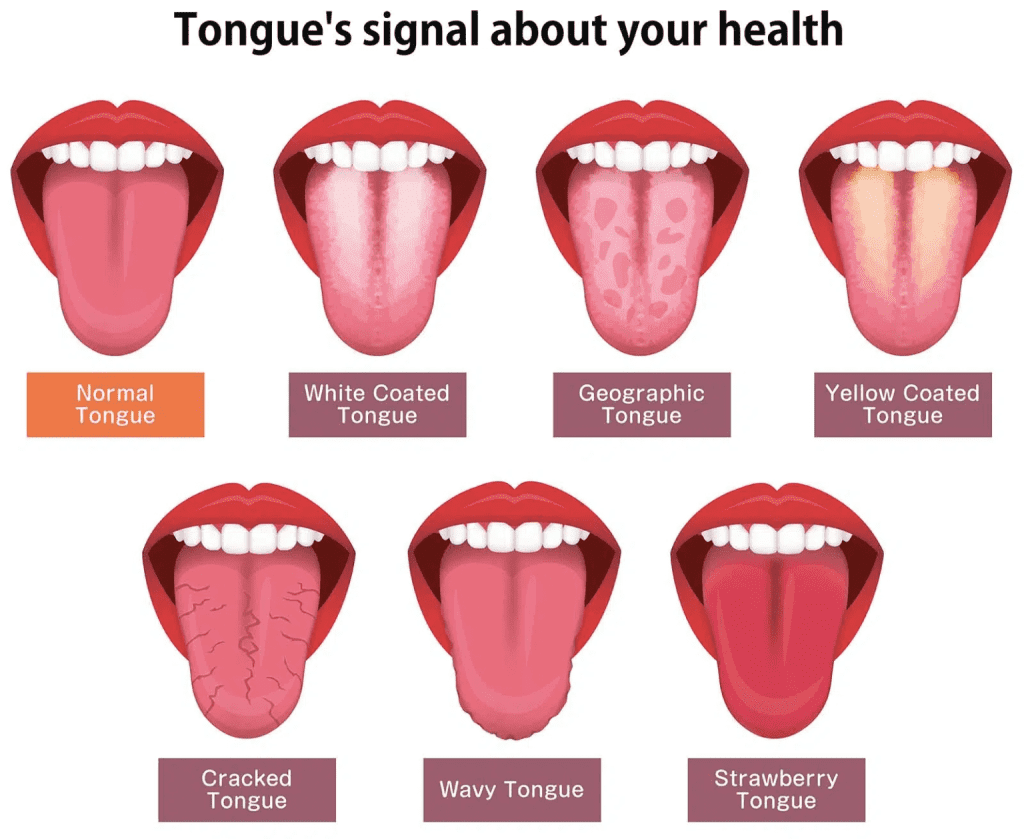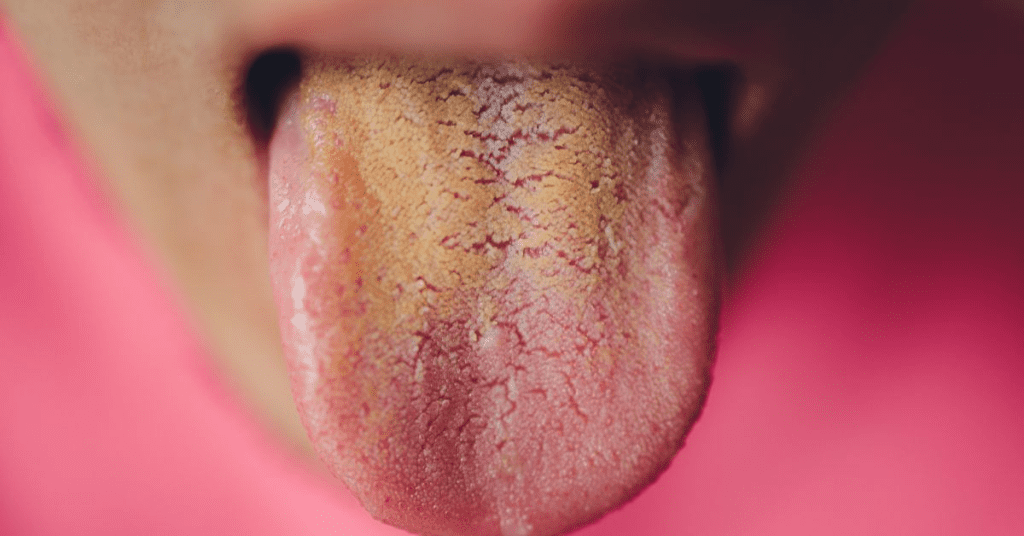Often overlooked, your tongue can be a surprisingly accurate indicator of your overall health. Changes in its color, texture, or moisture levels can reveal early signs of health issues, from minor deficiencies to serious conditions. This article explores what your tongue might be trying to tell you about your body, so you can take action early and maintain a balanced, healthy lifestyle.

Understanding the Signs of a Healthy Tongue
In its healthiest state, a tongue appears pink, moist, and covered in small nodules called papillae. These tiny bumps are responsible for helping you taste flavors and give the tongue its characteristic texture. Any major changes in appearance, texture, or color may be signs that something in the body isn’t quite right. A careful look can reveal whether a condition is minor, like dehydration, or more serious, such as a systemic illness.
1. White Coating or Patches on the Tongue
A white coating or patchy appearance on the tongue can indicate different health issues, ranging from minor to serious.
- Oral Thrush: This common condition is caused by an overgrowth of Candida yeast, resulting in a white coating or patches that may be uncomfortable. Oral thrush is more likely in those with weakened immune systems, diabetes, or those using dentures.
- Leukoplakia: Often appearing as thick, white patches that can’t be scraped off, leukoplakia is typically benign but can occasionally signal a risk for oral cancer. This condition is often seen in individuals who use tobacco or consume excessive alcohol.
2. A Red or Glossy Tongue
If your tongue appears red, swollen, or glossy, it may be due to certain vitamin deficiencies or other underlying conditions.
- Nutritional Deficiencies: A bright red or smooth tongue could point to deficiencies in essential vitamins, especially B12 and folic acid. These nutrients are crucial for maintaining the health and appearance of the tongue, and their absence can lead to a condition called glossitis, where the tongue swells and changes color.
- Geographic Tongue: This harmless condition, also known as benign migratory glossitis, is characterized by red, map-like patches on the tongue with white borders. The patches may shift location and shape over time. While the exact cause is unknown, it’s thought to be linked to genetics or environmental factors.
- Kawasaki Disease and Scarlet Fever: These pediatric conditions often present with a bright red tongue. Kawasaki Disease is an inflammatory condition primarily affecting children under five, while Scarlet Fever, caused by a Streptococcus infection, results in a “strawberry tongue” alongside a bright red rash. Both require prompt medical attention, especially in children.
3. Purple or Blue Tongue
A purple or blue-tinged tongue could be a sign of circulation issues, indicating a possible deficiency in oxygen throughout the body. This can be linked to respiratory or cardiovascular conditions that should be evaluated by a healthcare provider.

What Does a Yellow Tongue Mean?
A yellow tongue may have various underlying causes, some benign and others more serious. Common causes include:
- Poor Oral Hygiene: Buildup of bacteria, dead cells, and food particles can result in a yellowish coating on the tongue. Regular brushing and tongue scraping can help remove this buildup.
- Dry Mouth: A lack of saliva allows bacteria to grow, causing discoloration.
- Diet and Lifestyle Choices: Foods and drinks with strong pigments, such as coffee or tea, can stain the tongue. Smoking and mouth breathing can also lead to a yellow appearance.
- Jaundice: Though rare, jaundice can sometimes turn the tongue yellow, as it affects the body’s ability to process bilirubin, leading to yellowing of the skin, eyes, and, occasionally, the tongue.
If the yellow hue persists or other symptoms are present, it’s best to consult a healthcare provider for further evaluation.
What Can a Cracked or Fissured Tongue Indicate?
Cracks or fissures on the tongue, known as a fissured tongue, are generally harmless but can have a range of causes:
- Normal Variation: For many, a cracked or fissured tongue is simply a natural variation and may even be hereditary.
- Dehydration: Insufficient hydration can lead to a dry and cracked tongue. Staying hydrated can often resolve this issue.
- Geographic Tongue: In some cases, geographic tongue can also present with cracks or fissures, which may shift over time.
- Nutritional Deficiencies: Deficiencies in essential nutrients like vitamin B12, iron, or folic acid can cause changes in the tongue, including fissures or cracks.
- Autoimmune Disorders: Conditions such as Sjögren’s syndrome, which affects moisture-producing glands, can lead to a cracked tongue.

Signs of Nutritional Deficiencies on the Tongue
The tongue can also provide valuable clues about nutritional health. For instance, a bright red, swollen, and painful tongue often points to deficiencies in vitamin B12 or iron. This condition, which may include burning sensations, indicates the body’s need for these critical nutrients. Addressing these deficiencies with dietary changes or supplements can quickly improve both tongue health and overall wellness.
Oral Hygiene’s Role in Tongue Health
Good oral hygiene does more than just keep your smile bright—it’s vital for maintaining a healthy tongue. Regular tongue cleaning helps prevent buildup, which can lead to bad breath and discoloration. A white coating on the tongue, often a mix of bacteria, food particles, and dead cells, can be managed by incorporating tongue scraping and proper oral hygiene practices into your daily routine.
When to Seek Medical Advice
While changes in tongue appearance are often harmless, persistent or severe symptoms warrant medical evaluation. Watch for signs like unhealing sores, persistent lumps, or unusual patches that don’t resolve over time. These symptoms, especially if accompanied by other changes like difficulty swallowing or unexplained weight loss, may indicate more serious health issues, including oral cancer. Early intervention can be critical, so consult a healthcare provider if you notice any persistent abnormalities.
Conclusion: Listening to Your Tongue for Better Health
Your tongue is more than just a tool for tasting—it’s a reflection of your overall health. By paying attention to changes in its color, texture, and appearance, you can gain valuable insights into your body’s condition. Regular oral hygiene, adequate hydration, and addressing any persistent changes with a healthcare professional can help you maintain both oral and systemic health. Remember, your tongue can reveal more than meets the eye, making it an essential part of staying in tune with your body’s needs.


